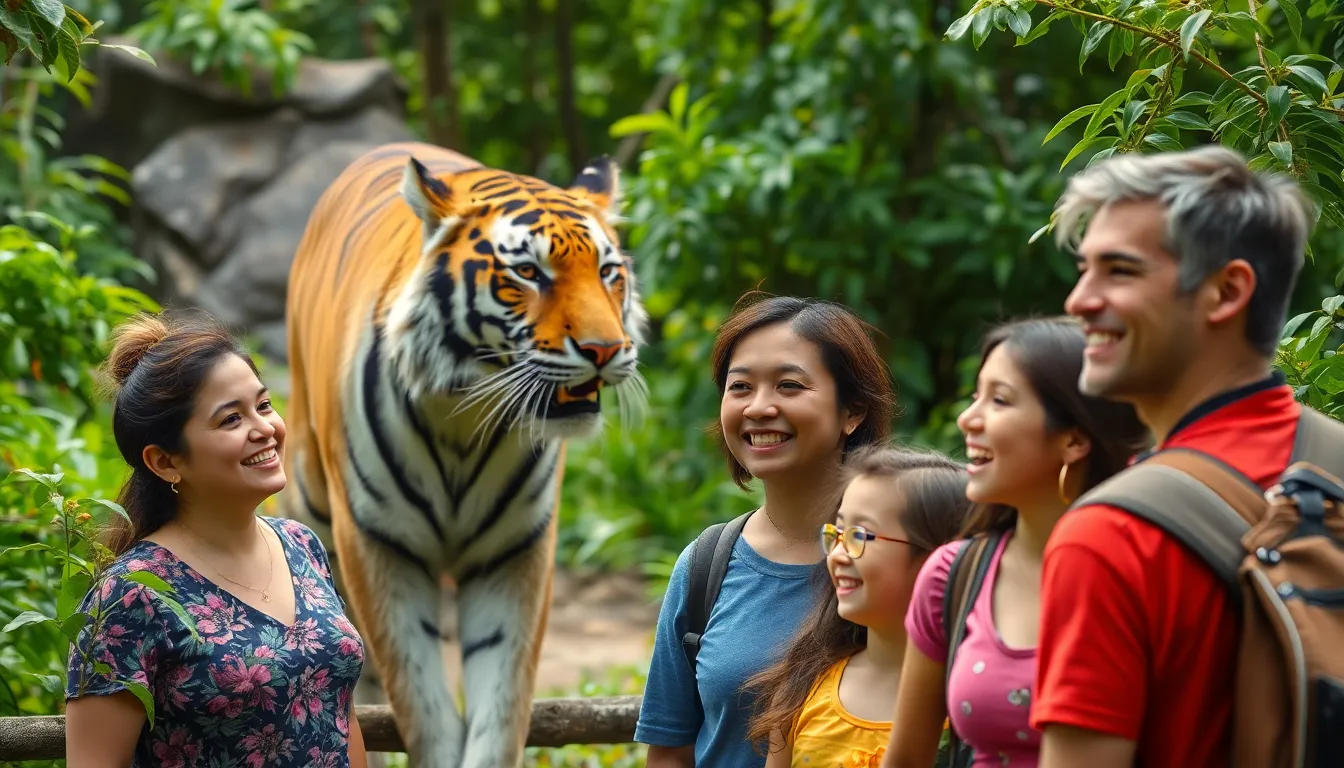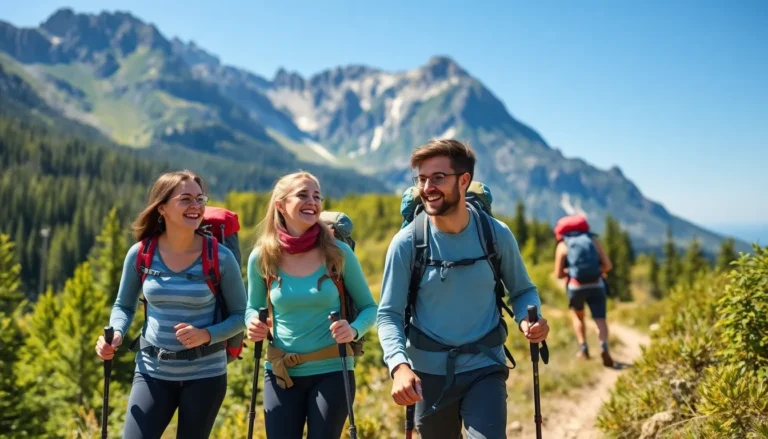Table of Contents
ToggleImagine swapping your daily grind for a thrilling adventure where the only deadlines are feeding time and nap time—yours and the animals’. Wildlife sanctuary travels offer a unique escape into nature’s playground, where you can connect with majestic creatures and support conservation efforts. It’s like a vacation for your soul, with a side of fur, feathers, and maybe even a little bit of danger (in the most fun way, of course).
From cuddly koalas to majestic elephants, these sanctuaries provide unforgettable experiences that leave a lasting impact. Not only do travelers get to witness wildlife up close, but they also contribute to vital efforts that protect these incredible species. So pack your bags and get ready for a wild journey that’s sure to make your Instagram followers a bit jealous. Who wouldn’t want to trade selfies with a sloth for a regular beach photo?
Overview of Wildlife Sanctuary Travels
Traveling to wildlife sanctuaries offers unique opportunities to engage with nature. Immersion in natural habitats allows individuals to witness animals in their own environments. Interactions often include close encounters with species like koalas, elephants, and various birds. Education about local ecosystems enhances the travel experience, creating deeper appreciation for wildlife.
Visitors contribute to conservation efforts by choosing sanctuaries that focus on rehabilitation and habitat preservation. Many sanctuaries operate on a model that fosters sustainable tourism while providing funding for ongoing conservation projects. Expenditures made by travelers often support these initiatives, emphasizing the mutual benefits of wildlife tourism.
Travelers seeking unforgettable experiences find that many sanctuaries provide guided tours led by knowledgeable staff. These tours offer insights into animal behavior, health, and conservation challenges. Engaging in activities such as feeding sessions or behind-the-scenes tours can further enrich visitors’ understanding and connection to the wildlife.
Choosing wildlife sanctuaries as travel destinations encourages responsible tourism practices. This kind of travel helps raise awareness regarding the plight of endangered species. Focus on ethical interactions ensures that visitor experiences do not harm the animals or their habitats.
Ultimately, wildlife sanctuary travels present an opportunity to appreciate biodiversity while actively supporting wildlife protection. Prioritizing conservation during travels not only enriches individual experiences, but it also plays a role in ensuring ecosystems thrive for generations to come.
Top Wildlife Sanctuaries to Visit

Exploring wildlife sanctuaries offers incredible experiences and unique opportunities to connect with nature. Here are two top choices for animal lovers seeking memorable adventures.
Sanctuary 1: Features and Attractions
The first sanctuary provides a sanctuary for various endangered species. Visitors can observe majestic tigers and playful monkeys in their natural habitats. Guided tours focus on wildlife rehabilitation, allowing interactions that emphasize education about conservation needs. Families enjoy educational programs that engage children, fostering an appreciation for environmental stewardship. Facilities include well-maintained viewing areas and learning centers that enhance the overall experience. Visitors often share how captivating it is to witness animal behaviors up close, strengthening the bond between guests and wildlife.
Sanctuary 2: Features and Attractions
The second sanctuary specializes in the protection of marine life. At this coastal refuge, visitors can see sea turtles and playful dolphins in a safe environment. Engaging activities include snorkeling excursions that showcase coral reefs and their inhabitants. Knowledgeable guides lead educational sessions about the challenges marine ecosystems face. This sanctuary prioritizes hands-on experiences, allowing guests to participate in beach clean-ups and conservation efforts. Many find it fulfilling to take part in protecting the ocean while enjoying unforgettable encounters with marine species.
Planning Your Wildlife Sanctuary Travel
Planning enhances the overall experience of wildlife sanctuary travels. Knowing when to visit and what to bring makes for a smoother journey.
Best Times to Visit
Seasons greatly influence the wildlife experience. Most sanctuaries thrive during spring or autumn, ensuring pleasant weather and active animals. For instance, many species are more visible during these months due to mating behaviors or migration patterns. Travelers might consider visiting between March and June for blooming landscapes and vibrant wildlife. Additionally, some sanctuaries host special events during specific seasons that offer unique experiences. Researching local climate conditions helps ensure a comfortable visit, especially in distinguished areas known for distinct weather.
Essential Packing List
A well-prepared traveler enjoys a seamless visit. Packing essentials should include binoculars for observing animals closely. Comfortable clothing suitable for various weather conditions enhances outdoor adventures. Sturdy walking shoes are crucial for exploring sanctuary trails. Sunscreen and insect repellent protect against the elements and pests. A refillable water bottle ensures hydration while participating in activities. In addition, bringing a camera captures memorable moments with animals. Lightweight, portable snacks keep energy levels up during excursions. Lastly, consider including a small notebook for jotting down insights and experiences.
Conservation Efforts in Wildlife Sanctuaries
Wildlife sanctuaries play a vital role in conservation by protecting endangered species and their habitats. Organizations prioritize rehabilitation and release programs, focusing on restoring wildlife to their natural environments. Educational initiatives engage visitors, highlighting the importance of species protection and ecosystem health.
Effective conservation strategies involve habitat preservation. Many sanctuaries implement breeding programs that maximize genetic diversity among species. These efforts help sustain populations of animals at risk of extinction. Programs emphasize research on animal behavior and health, informing practices that enhance their well-being.
Funds generated from visitor fees directly support sanctuary operations, including conservation projects. Engaging in hands-on activities, such as habitat restoration and clean-up efforts, empowers guests to contribute actively. Learning about local ecosystems fosters a sense of responsibility towards wildlife.
Guided tours offer unique insights into endangered species’ challenges. Experts provide information on poaching, habitat loss, and climate change, illustrating the urgent need for action. By participating in these tours, visitors deepen their understanding of conservation efforts in real-world contexts.
Communities surrounding wildlife sanctuaries often benefit from conservation initiatives. Local education programs raise awareness and promote sustainable tourism. Collaborations with local leaders enhance conservation activities and empower residents to advocate for wildlife protection.
Wildlife sanctuaries exemplify dedication to preserving biodiversity. They provide safe havens for animals while promoting a sustainable future. Responsible tourism practices ensure ethical interactions, ultimately advancing global conservation efforts.
Personal Experiences and Stories
Travelers often share incredible stories from their visits to wildlife sanctuaries. Finding themselves up close to elephants can evoke a sense of awe and wonder. Participants in guided tours frequently describe the thrill of watching playful monkeys interact in their natural environments. Observing these behaviors enhances understanding of wildlife and fosters appreciation for diverse ecosystems.
Some visitors recount transformative experiences during rehabilitation opportunities. Engaging with rescued animals adds a personal touch to their travels. Every encounter with a unique creature has the potential to spark a passion for conservation. Travelers also note how meaningful it feels to contribute to habitat preservation during their stay.
In one sanctuary, a family shared their joy in participating in a beach clean-up event. Their children discovered the impact of human actions on marine life, developing a sense of responsibility. Learning firsthand about local habitats often leads to lifelong commitment to wildlife advocacy.
Another traveler highlighted encountering a guide who explained the challenges of endangered species. Personal anecdotes about poaching and climate change resonated deeply, illustrating the real-world implications of these issues. Hearing stories directly from those involved in conservation reinforced the visitors’ dedication to ethical wildlife interactions.
Observations of vibrant flora and fauna often inspire travelers to document their experiences. Many keep journals filled with insights from their journeys, capturing photographs of unforgettable moments. Sharing these stories with friends and family stimulates interest, encouraging others to consider wildlife sanctuary travels. Engaging in conversations about their experiences contributes to raising awareness about responsible tourism practices.
Wildlife sanctuary travels offer an enriching blend of adventure and education. By choosing to visit these sanctuaries, travelers not only create unforgettable memories but also actively support crucial conservation efforts. Engaging with animals in their natural habitats deepens appreciation for the environment and fosters a sense of responsibility toward protecting it.
As more people embrace this form of tourism, the positive impact on local ecosystems and communities becomes increasingly significant. Each visit contributes to the ongoing fight against species extinction and habitat destruction. By prioritizing ethical interactions and sustainable practices, travelers can ensure that their journeys contribute to a brighter future for wildlife and the planet.







